The map that saved the London Underground
- Published

You must have JavaScript enabled to view this content.
A zoomable version of this map is available on the desktop site
Explore the 1914 Wonderground Underground map

Europe was about to tear itself apart, but Londoners in 1914 were more preoccupied with the overcrowding on the Tube and a profanity uttered in a new West End play.
Just outside St Paul's, the Tube train hiccoughs twice, then stops. The bearded man in painter's overalls squashed beside me asks rhetorically why we should pay such ludicrous ticket prices for such a geriatric transport network? A flood of complaints echoes him: "London's going to the dogs!"
Suddenly, there's a bellow of laughter and the bearded man points at the priority seat for the elderly and disabled. In the round typeface, synonymous with the London Underground, someone has replaced the sticker with one of his own.
"Priority seat for persons with gonorrhoea and genital herpes," it reads.
A raucous cheer breaks out and a round of applause. "You gotta laugh," winks the bearded man. "I mean, at least we can still laugh, eh?"

Liverpool Street Station - a less inviting place in 1914
Let's ease the train backwards… While everyone is still chortling together in a newfound spirit of camaraderie, let's glide the carriage back through the tunnel, back 100 years or so.
Can you feel the carriage air getting even tighter in and closer? I'm sorry there's no seat for you, but it's rush hour and at least 70 grumbling commuters are squashed in what's commonly termed the "padded cell". You can only tell you've arrived at the station because the guard is shouting the station's name. "Post Office! Post Office!" Almost a quarter of a century will have to pass before you can get off at the station we know as St Paul's again.
Two-and-a-half miles to the west, at the London Underground's Electric Railway headquarters in Victoria, the network's newly appointed commercial director, Frank Pick, is perhaps leafing through the complaints letters on his desk. Passengers are moaning about unpunctuality, about overcrowding, about confusion and dirt. The Tube, crammed on workdays (some 400,000 people now work in the heart of the city) is virtually empty at weekends and holidays and the company is fast losing money and public support. What we need, thinks Pick, is stronger branding.
He's already commissioned a calligrapher, Edward Johnston, to create an iconic typeface for the Tube―the Johnston Sans lettering still spells out London's Tube stations today. But now Pick wants some eye-catching posters, distinct from general advertisement bills, that will make Londoners of all social classes proud to journey around their city and visit its attractions. An Eric Gill who helped Johnston develop the typeface has a younger brother Macdonald, known as Max, who's an architect and designer. Pick visits him and explains his vision.
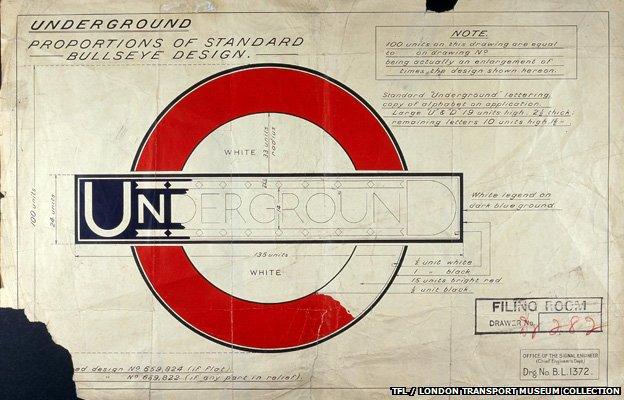
Edward Johnston's original design for the London Underground symbol
"And Max," he adds, "We've got to make those commuters laugh!"
Macdonald Gill's primary coloured Wonderground map was published early in 1914 and was hung at every station. A mixture of cartoon, fantasy, and topological accuracy, it was an instant hit with the travelling public.
He silences critics by writing disdainfully in one corner, "Scale of six inches to one mile―can't you read?" It became the first London Underground poster to be sold commercially for homes and offices.
1914 London, with its population of seven million, was the capital of the largest empire the world had ever seen. Gill reminds commuters of its grandeur with a sign pointing off the eastern edge of the map boasting: "This is the way to Victoria Park, Wanstead Flats, Harwich, Russia and other villages."

Listen to the story behind the Wonderground map, as told by Macdonald Gill's nephew Andrew Johnston. (Not available on mobiles)

London is presented as a medieval walled town, with a curved horizon like the medieval world map's enclosing circle, all bound by a decorative border in which heraldic coats of arms give a sense of London's great history and heritage. Yet, drawn in the vibrant colours of the Fauvists, it captured the mood of a busy, bustling contemporary London going about its business. Just as today's smartphone users are distracted by the presence of wi-fi at Tube stations, so the passengers of 1914 were absorbed by the Lilliputian minutiae of the map―they repeatedly missed trains as they gawped at the figurines' quips and guffawed at the contemporary jokes.
Jibes such as the one aimed at the French pilot depicted hovering in an upside down plane over London asking passing birds whether they'd looped the loop yet. In the autumn of 1913, Le Roi du Ciel, Adolphe Pegoud, had performed that first aerial stunt at Brooklands airfield on London's outskirts before a crowd of 50,000 people. Upon landing safely, the moustachioed little Frenchman had brushed away awe-struck British reporters with a nonchalant Gallic wave of his hand saying, "Head up, head down―it's all the same to me!"
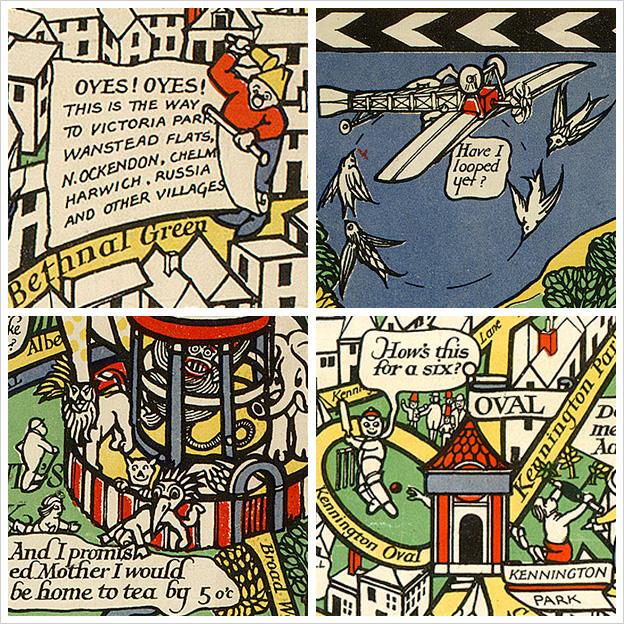
Use the zoomable map at the top of the page to explore the Wonderground Underground (not on mobiles)
Down at the Kennington Oval, a proud cricketer swings his bat and asks, "How's this for a six?" - a patriotic in-joke as England was celebrating winning an away series against South Africa, with the great Jack Hobbs being the talk of the town. There were visual jokes too for London's youth - at Regent's Park Zoo a prehistoric-looking bird eats a child through the bars of its cage as the child laments, "And I promised mother I'd be home for tea by five!"
Most of Max's characters' speech bubbles are written in 1914 Cockney - "Are you sure them gas tubs is full, Bernard?" calls one worker to another. "Nothink like wortur for a chainge Bill," says a man as he dives into a reservoir.
Accent, class and social mobility were major preoccupations of 1914 London. The new poet laureate, Robert Bridges, had temporarily ceased to pen poetry and was instead concentrating on writing A Tract on the Present State of English Pronunciation. His pamphlet attacked what he called "the corrupted vowels….of London vulgarity". He feared the "clipped and slovenly London jargon" would overwhelm the "older tradition"―and founded The Society for Pure English.
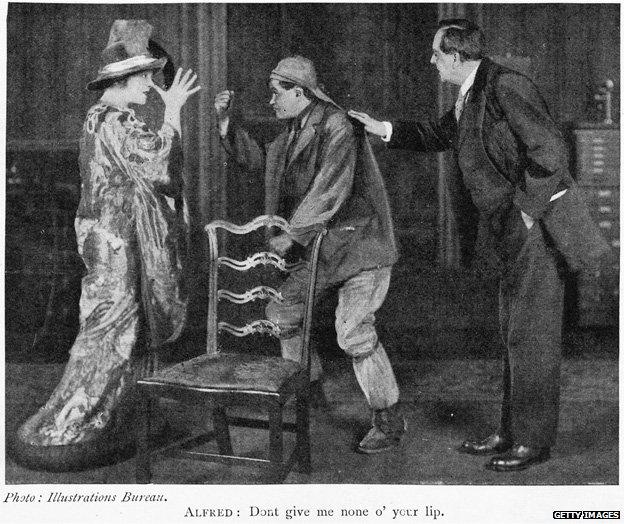
But even that couldn't keep out Eliza Doolittle.
On 11 April 1914, at His Majesty's Theatre - which Max would draw the following year in his subsequent Tube map Theatreland - Mrs Patrick Campbell waited in the wings for the curtain to go up on George Bernard Shaw's new play, Pygmalion. She would play the common little flower girl who's taught by a pompous professor of phonetics to "talk proper", like a duchess. Rehearsals had been stormy, as Higgins - played by the flamboyant, practical joker Sir Herbert Beerbohm Tree - didn't get along with the serious Shaw.
London audiences swarmed into the theatre out of prurient interest - the play had already been staged in Vienna and America and everyone knew it contained the profane and forbidden line: "Not bloody likely!" Would Mrs Campbell dare pronounce it or would the censors silence her? She did dare - and the delighted audience laughed for over a minute at the decadence of it all.
Shaw of course had regarded his work as a serious social satire on modern manners, and was so appalled that Londoners seemed only to thrill at his use of a swear word that he walked out.

Emmeline Pankhurst is arrested at a protest outside Buckingham Palace
If Eliza Doolittle had walked into Max Gill's map, she would have joined the long-skirted, bonneted beings who do nothing more than push prams or hold children's hands. Yet by the publication date, Emily Davison had already died under the King's horse on Derby day and Emmeline Pankhurst's Women's Social and Political Union had long been orchestrating a very public programme of heckling politicians, setting fire to post boxes, disrupting courtrooms and chaining themselves to railings.
By May, five paintings in the National Gallery had been attacked - Velasquez's Venus received seven slashes across her beautiful back from Canadian suffragette Mary Richardson. And at the Royal Academy, Mary Wood, screaming, "Votes for Women!' took a meat cleaver to Sargent's portrait of Henry James. When the suffragettes smashed a glass case in the British Museum containing an Egyptian mummy, London's other museums temporarily closed. And the British Museum announced that, in future, women would only be admitted with a ticket issued on receipt of a letter from a person "willing to be responsible for their behaviour".
Max's map, restrained by its commercial purpose, preserved London in a fairytale 1914 where anything unpleasant could simply be laughed off or indeed missed out. But among the puns and japes, he gives just a couple of subtle hints at underlying social problems such as the massive and growing gap between the rich and poor.
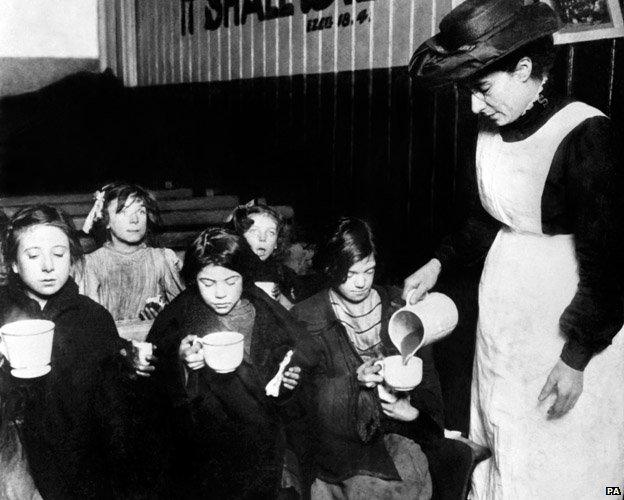
Breakfast from the Salvation Army
In 1913, the Fabian activist Maud Pember Reeves had published the shocking Round about a Pound a Week. Her four-year study among the working poor in Lambeth revealed the extent of food poverty families were suffering and the high mortality rate of their children.

Photo: Lordprice Collection / Alamy
Soup kitchens had opened up along the Embankment and in the parish of St Martin-in-the-Fields, the new vicar Dick Shepherd, offered the church crypt as a night shelter for the homeless, declaring St Martin's should be "the church of the ever-open door". Its doors have been open ever since to London's down-and-outs.
Meanwhile, the City had become all-powerful - described by the Economist as "the banker and financier of the universe" - and the Stock Exchange was making traders an awesome amount of cash. The Chancellor of the Exchequer, David Lloyd George, worried this new money would create an arrogant class of "self seekers… and footballers".
Industrialists feared London was in danger of losing her manufacturing competitiveness by focusing on finance. In the Wonderground map, a labourer straining to pull a plough uphill calls out, "Harrowing work this!" to a disdainful, cravat-sporting gentleman who sneers back with a flick of his umbrella: "What is work? Is it a herb?"
By the end of July, the jokes were over. Within days, Germany would invade Luxembourg and Belgium and would head for France. From the War Office - an insignificant tiny black square on Gill's map - Lord Kitchener appealed for volunteers for his Army. Hundreds of thousands of new recruits flooded the Underground on their way to training camps. Doing its bit, the Underground authorities allowed all uniformed men to travel free until October 1914.
As they waited on the station platforms, the young soldiers would have seen the whimsical Wonderground posters. For many of them it would be their very last look at the old Town, resplendent in fairytale, primary colours, before the black tunnels swallowed them up.
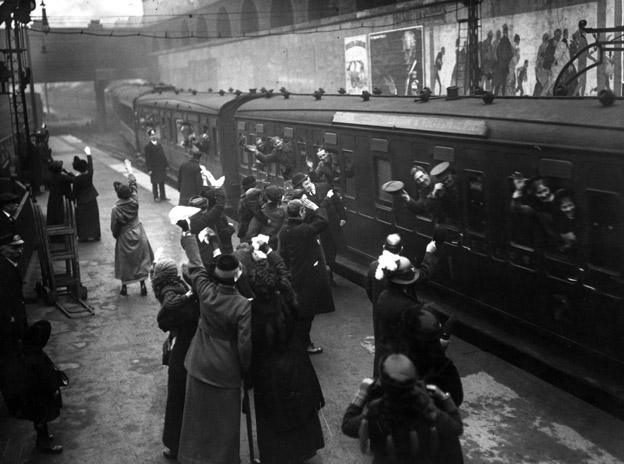
Waving goodbye to loved ones and to London at Victoria station, 1915
At the bottom of the map, Macdonald had drawn his big brother, Eric Gill. As Max delighted in his splashes of garish colours and cartoons for the Wonderground, Eric had been silently working on his own stark commission for Westminster Cathedral - the first of 14 carved stone panels of the Stations of the Cross, the representation of Christ's last, bleak journey on the road to crucifixion.
Let's move forward again and get back on our packed tube that continues to be stuck outside St Paul's. Everyone's still laughing at the gonorrhoea sticker and the anger has dissipated. The bearded man in painter's overalls asks if anyone's seen that great poster the Underground's just done with the FA, renaming all the stations after football stars… St Paul's had been transformed into the Scottish striker Denis Law…
I want to tell everyone that it's all because of a comical map drawn in 1914, a map designed to cheer up angry commuters like us when the trains were late. It's because of that 1914 map and its commercial success that there's still Art on the Underground and that Frank Pick went on to commission so many other artists to design posters for the Tube. It's partly because of that map that Tube posters have become a respected art medium.
But the train jolts and starts to grind forwards again and the Wonderground's ghost stations - Down Street, Dover Street, Mark Street and Post Office - fade away as we pull into the bright, electric lights of St Paul's.
Follow @BBCNewsMagazine, external on Twitter and on Facebook, external
Find out more about the centenary of the outbreak of World War One at BBC Online
Music on the Brink: The Essay series is broadcast Monday to Friday this week at 22:45 GMT on BBC Radio 3. Monday: Vienna. Tuesday: Paris. Wednesday: Berlin. Thursday: St Petersburg. Friday: London. You can listen to the whole series on BBC iPlayer.
Slideshow production by Paul Kerley. Music by KPM Music. All images subject to copyright. Images courtesy London Transport Museum (TFL), Caroline Walker and Andrew Johnston.
London Transport Museum's World War One exhibition Goodbye Piccadilly, from the home front to the Western Front, opens on 16 May 2014
